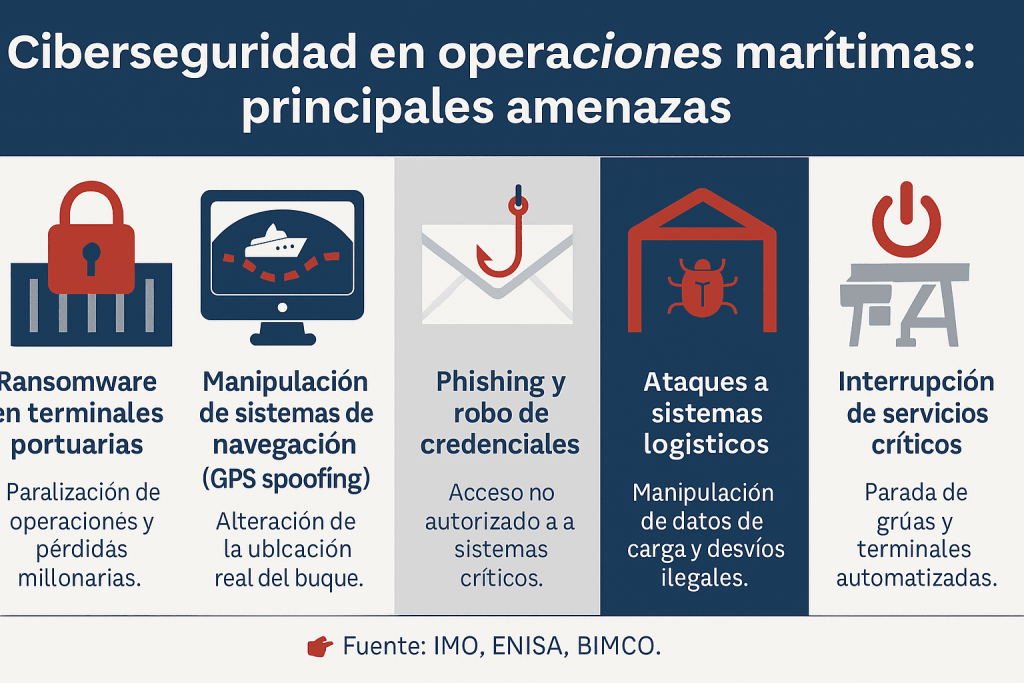
Cybersecurity in maritime operations has become a fundamental pillar for ensuring the continuity of global trade. In a sector where more than 80% of international goods are transported by sea, the risks of cyber attacks on ships, terminals and port management systems represent a real and growing threat.
From ransomware that paralyses logistics terminals to cyberattacks on ship navigation systems, digital threats are no longer hypothetical, but rather cases that have been recorded in some of the world’s major ports.
In this article, we will analyse the most common threats, the international regulations governing maritime cybersecurity, and the technological solutions being adopted to strengthen protection in this critical environment.
Somos provisionistas generales de buques
Descubre todos nuestros servicios de suministros navales y marítimos.
1. Most common cybersecurity threats in maritime operations
The maritime sector is particularly vulnerable due to the digitisation of its operations and the interconnection of multiple actors (shipping companies, ports, authorities, logistics providers). Among the most notable risks are:
a) Ransomware in port terminals
- Cases such as the NotPetya attack (2017) that affected Maersk demonstrate the magnitude of the problem: the shipping company lost more than $300 million and key ports were paralysed for days.
b) Manipulation of navigation systems (GPS spoofing)
- Cybercriminals can alter a ship’s GPS signal, changing its actual location and putting both the crew and cargo at risk.
c) Phishing and credential theft
- Crews and port employees are targeted by phishing campaigns, opening the door to unauthorised access to critical systems.
d) Attacks on freight and logistics systems
- Data manipulation in container management systems can lead to logistical chaos, unauthorised diversions or even the introduction of illicit goods into the supply chain.
e) Interruption of critical services
- Automated ports, cranes, and management systems depend on secure networks. A targeted attack can halt operations and cause millions in losses within hours.

2. Key regulations in cybersecurity in maritime operations
To respond to this growing threat, international organisations have developed specific regulatory frameworks:
a) IMO 2021 – Mandatory requirements
Since January 2021, the International Maritime Organisation (IMO) requires shipowners to integrate cybersecurity into Safety Management Systems (SMS) in accordance with the ISM Code.
👉 More information: IMO Cyber Risk Management.
b) European Union NIS2 Directive
Applies to critical infrastructure, including ports. Requires the implementation of cyber risk management measures and the reporting of security incidents.
👉 Details: European Commission – NIS2.
c) BIMCO Guidelines
The BIMCO association has published reference guides that are used by shipping companies to establish response protocols for cybersecurity incidents in maritime operations.
👉 See: BIMCO Cyber Security.
d) ISO/IEC 27001
More and more shipping companies are adopting this international standard for information security management as a benchmark for securing their digital operations.
3. Software and infrastructure solutions to strengthen cybersecurity
The fight against cyberattacks in maritime operations requires a combination of technology, processes and human training. Among the main solutions are:
a) Intrusion detection and prevention systems (IDS/IPS)
They monitor the ship or port network in real time, identifying abnormal behaviour and blocking suspicious access.
b) OT/IT network segmentation
Separating operational technology (OT) networks (such as crane control and navigation systems) from information technology (IT) networks minimises the spread of a potential attack.
c) Encryption of communications
The use of secure protocols (VPN, TLS) in ship-to-shore communications is essential to protect sensitive data from external access.
d) Backups and recovery plans
Having up-to-date backups and contingency plans in place allows operations to resume in the event of a cyber incident, minimising the economic impact.
e) Training of crews and port personnel
Continuous training in cybersecurity is key. According to the European Union Agency for Cybersecurity (ENISA), 80% of cyber incidents are due to human error.
f) Artificial intelligence applied to cybersecurity in maritime operations
The use of AI algorithms helps detect anomalous patterns in the network, identify intrusion attempts, and automatically respond to emerging threats.
4. Case studies and lessons learned
- Port of Los Angeles (USA): implemented a cybersecurity centre in collaboration with the FBI to monitor threats in real time.
- Shipping companies such as MSC and CMA CGM have suffered attacks in recent years, prompting millions of pounds of investment in digital protection systems.
- Spain: The Port Authority of Valencia participates in European innovation programmes on port cybersecurity, integrating IoT and blockchain to improve data traceability and security.
5. Benefits of a robust cybersecurity strategy
- Business continuity: minimises disruptions to maritime transport.
- Global supply chain protection: prevents critical goods (food, medicines, energy) from being affected.
- Regulatory compliance: avoid penalties and reputational damage.
- Competitive advantage: Ports and shipping companies that demonstrate high standards of digital security generate greater trust among customers and partners.
Conclusions
Cybersecurity in maritime operations is now a strategic priority for the sector. Threats are growing in complexity, but so are the available solutions. Implementing digital protection systems, complying with international regulations and training staff are essential steps to ensure safer, more resilient and competitive maritime transport.
Companies that invest in cybersecurity will not only protect their assets, but will also establish themselves as key players in a global industry that cannot afford any interruptions in its operations.



